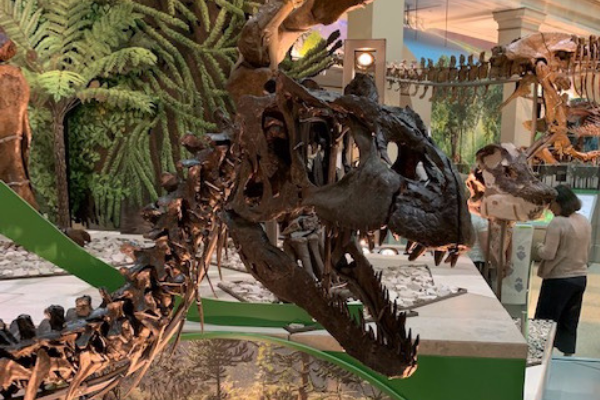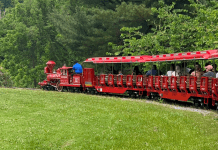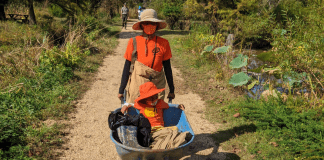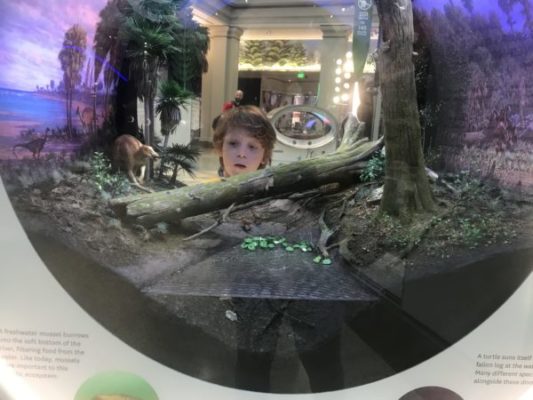
The dinosaurs are back on the National Mall! The Smithsonian National Museum of Natural History opens its spectacular, newly-renovated fossil hall this weekend. If your children are dinosaur fans, you have to check this out. And if your children are not dinosaur fans, they probably will be after you see this exhibit.
The new fossil hall, called the “Deep Time” exhibit, is a treasure trove for dinosaur enthusiasts of all ages: from the towering Tyrannosaurus rex that looks like it is about to devour a triceratops, to the tiny dioramas that show a slice of life at different periods in Earth’s history. Touch screens, videos, and interactive displays take visitors deeper. You can explore the fossil record, the evolution of life, and the effects of climate change throughout Earth’s history.
The museum first opened its dinosaur hall in 1911, called the “hall of extinct monsters.” It has undergone several renovations over the years. Most of the Smithsonian’s dinosaur fossils have been off display for the past five years during this latest $125 million renovation. The Deep Time exhibit brings back the old fossils with new stars, like one of the largest and most complete Tyrannosaurus rex skeletons. The museum also restored the hall itself to its original grandeur, opening up the ceiling and restoring the Beaux-Arts style.
The Smithsonian acquired the “Nation’s T. rex” in 2014, after a hiker discovered it in Montana in 1988.
Dinosaurs for everybody
My oldest son was three years old when the Natural History Museum shuttered its dinosaur hall for renovation. I remember taking him and his infant brother to the museum to say goodbye to the fossils in 2014. As I recall, that visit included a lot of roaring, some stomping, and a request for a toy.
I was able to take my son back to the fossil hall this week for a sneak peak at the Deep Time exhibit. He stared wide-eyed at the towering dinosaur fossils, of course. But what really captured his interest were the smaller displays: the dioramas, touch screens, and videos. All are placed at the perfect height for a child or someone in a wheelchair.
The Deep Time exhibit covers millions of years of history but can take as long as you have to give it. There are hours of material to interest older children who want to read, watch the videos, and interact with the games and activities. But if you are with a kid with a 5-minute attention span, you can easily hit the highlights. The largest and most impressive dinosaur fossils are easily accessible along the center hall.
There is a great interactive area for kids along the back wall toward the African voices exhibit. Children can practice dating fossils, play a game to try to “become” a fossil, or learn about the carbon cycle. Volunteers and museum educators will also run interactive learning stations, like a game to try to match fossilized footprints with the animal that may have left them.
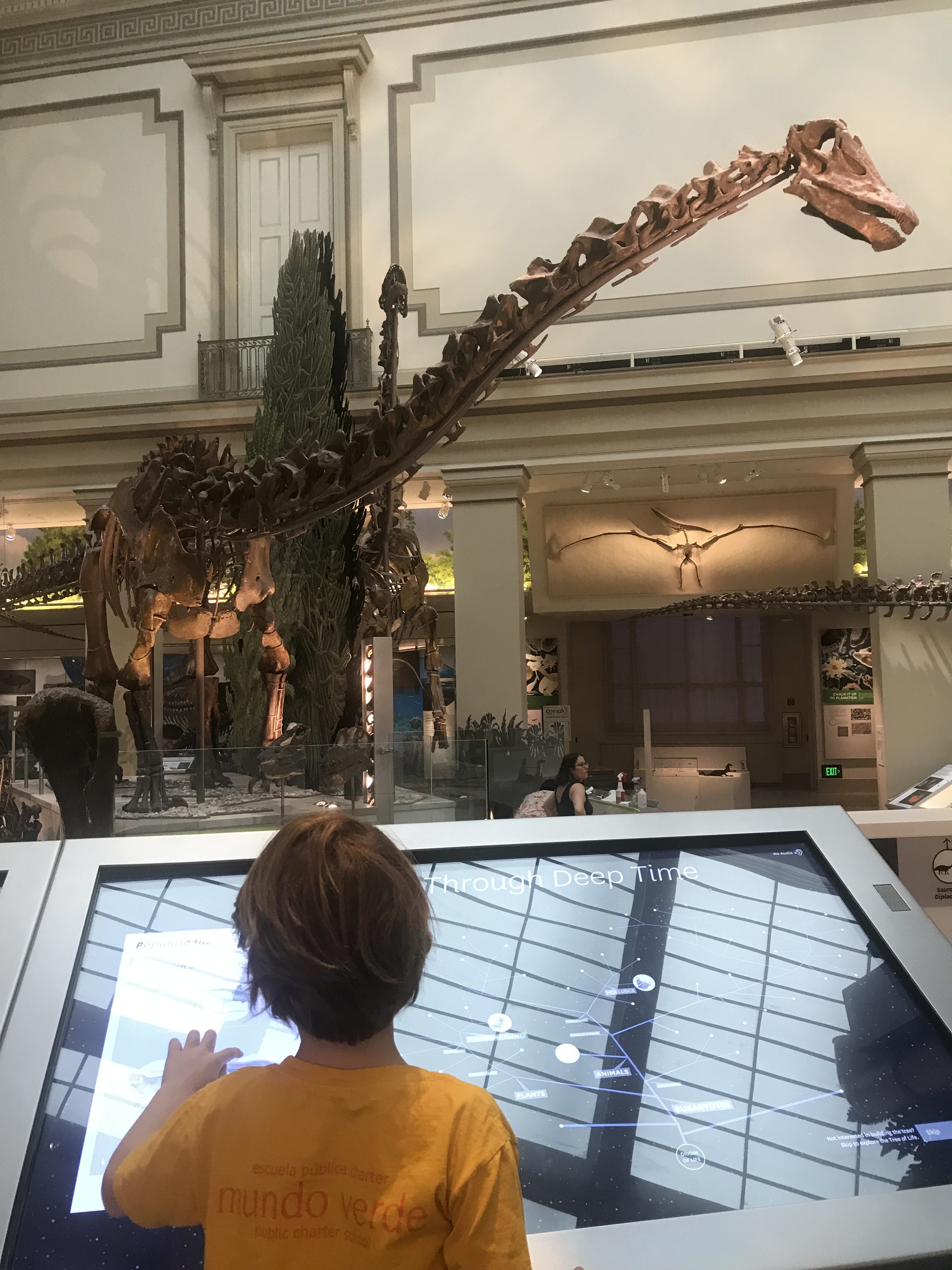
What about the crowds?
The Deep Time exhibit does not have tickets. Guests will be admitted on a first-come, first-in basis. Expect crowds. Even while the fossil hall was under renovation, the Natural History Museum was one of the most popular museums in D.C., with 4.8 million visitors last year.
For opening morning on Saturday, June 8, the first 300 guests in line outside the museum will be brought in for a ribbon-cutting. But if you live in the D.C.-area and don’t feel the need to be one of those first few hundred in the door, you may want to wait a while to come to the museum. After tens of millions of years, these fossils are used to waiting around. They will still be here.
One strategy to avoid the crowds: try to visit on a weekday evening this summer. The Natural History Museum will keep some late hours to offer more opportunities to see the new exhibit. The museum will be open until 7:30 pm daily in June (except June 20). In July and August, the museum will be open until 7:30 pm on Thursdays, Fridays, and Saturdays.
On a normal day, the Deep Time exhibit has two points of entry: one from the central rotunda and another from the African voices exhibition. But when crowds are heavy and the fossil hall reaches capacity, the museum plans to close the rotunda entrance and line up guests through the African voices hall.
Hold fossils in your hands
There are several other places in the Natural History Museum where you can get an up-close look at fossils. If the Deep Time exhibit is too crowded and your children are roaring for dinosaurs, just head upstairs. Visitors can see more specimens in the Last American Dinosaurs on the 2nd floor. The museum created this exhibit to scratch our dino itch during the renovation years. They plan to keep it open at least through the summer to help with overflow.
Your young explorer can also hold real fossils in their hands and examine them with microscopes in Q?rius and Q?rius Jr., the museum’s hands-on science education centers for kids. This place is a real treasure! Q?rius is designed for tweens and teens, with drawers containing thousands of real specimens they can examine under microscopes.
Q?rius jr. is designed for K-5th graders, but there is plenty to amaze younger children here too. Visitors can look at real museum objects and artifacts: fossils, skulls, shells and minerals. Kids can use a microscope or try on traditional clothing from around the world. Q?rius is open daily from 10-5. The labs are downstairs, on the ground level near the Constitution Avenue entrance.
Visiting logistics: strollers, snacks, and souvenirs
Visiting with strollers or wheelchairs: There are accessibility ramps for wheelchairs and strollers on both sides of the building. The entrance on the National Mall side has a new ramp, making it accessible for the first time. Strollers are allowed in the museum and there is no designated stroller parking spot.
Nursing in the museum: You may nurse your baby anywhere in the museum, but if you or your baby need more privacy, the Natural History Museum has a new nursing lounge that just opened. It is located downstairs in the Constitution Avenue lobby, next to the stairs with the totem pole.
Know your gift shops: I like to be aware of gift shops whenever I visit a museum, so I can steer my children toward or away from them, as needed. There is one merchandise booth right outside the Deep Time exhibit, in the museum’s rotunda, with a small (but enticing) selection of dinosaur-related merchandise. The museum’s larger gift shops are downstairs, including the “family” gift shop that has a lot of kid-friendly merchandise. My son enjoys saving up his allowance for this shop, especially a bag he can fill with rocks and minerals for $6.
Where to eat: There is a cafeteria on the second floor and a cafe on the ground floor. The cafeteria is worth a visit for the view alone: the museum recently installed a giant C. megalodon shark that hangs from the ceiling in the cafeteria. It’s not every day you can share your lunch with a mega-toothed shark! The official policy is that seating in the cafeteria is reserved for people purchasing food at the museum. Guests with bag lunches are encouraged to eat outside on the National Mall. There is no food allowed inside the exhibits.
What else to see with kids: Other great kid-friendly exhibits in the Natural History Museum include the insect zoo and butterfly pavilion. The butterfly pavilion requires tickets, but the timed tickets are free on Tuesdays!
